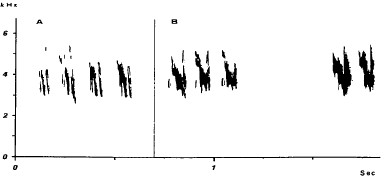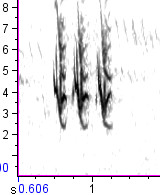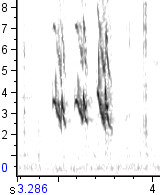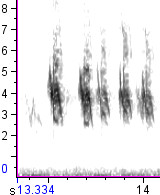Common and Hoary Redpolls
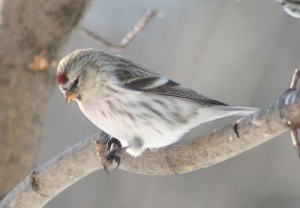
Last winter, in the Great Redpoll Invasion of 2012-2013, huge numbers of these little Arctic birds pushed farther south than anytime in recent memory, prompting a surge of interest in redpoll identification and taxonomy. My good friend Andy Boyce even got people talking about whether Hoary and Common Redpolls are separate species, or identifiable forms, and the many resulting discussions taught me (and others, I’m sure) a lot about how we define and detect species boundaries. And the conversation hasn’t quit: Tom Johnson and Luke Seitz are contributing with a redpoll identification article in the July/August issue of Birding.
During the course of these discussions, a couple people argued that Common and Hoary Redpolls have been shown to differ in vocalizations. To verify this claim, I set out to track down the relevant peer-reviewed literature, including a paper in Swedish, two key publications in Russian, and a book in German. It took some six months, but thanks to the help of a terrific interlibrary loan crew (and some assistance from Albert Lastukhin in Russia), I finally managed to get copies of all the sources. My dusty old fluency in Russian came in handy, as did my one year of college German. (Oh, and Google Translate.)
The original claims of differences in the literature
In 1981, Maria Zablotskaya provided a detailed spectrographic and behavioral analysis of the vocalizations of Common Redpoll; the following year, she teamed up with Boris Veprintsev to do the same for Hoary Redpoll. These authors are often cited as having found differences in the sounds of the two species, but it’s important to note that they did not explicitly address the issue of species differences (or species boundaries) at all. The first paper treated Common Redpoll only; the second paper discussed Hoary Redpoll only, with only a few passing comparisons to Common. They named several more calls for Common than they did for Hoary, but this is likely due to the fact that they spent less time with Hoaries and had fewer recordings available for analysis. A careful reading of both papers (along with Ernst 1998) shows that there probably aren’t any sounds in the repertoire of one species that don’t have an equivalent in the other species. This doesn’t necessarily mean that the species sound the same, but it does mean that they give similar types of calls.
In the face of doubt about whether the two redpoll species should be lumped, a couple of authors stepped forward in the mid- to late 1980s to defend the two-species concept. Ulf Molau’s (1985) “The redpoll complex in Sweden” focused on plumage and measurements, but also made the following important claims about vocalizations (translated from the Swedish by me, with help from Google Translate):
Common and Hoary Redpoll differ not only in size and plumage characters, but also in vocalizations. The low-key contact sounds uttered on the ground or in a tree crown (or in a cage) may in Common Redpoll be described as a catchy “chit-chit-chit.” Hoary Redpoll’s contact vocalization is a rougher, almost House Sparrow-like “chirp-chirp.” Similar differences also exist in the familiar “flight song” which is rougher and more metallic in Arctic Redpoll. Both Common Redpoll races flammea and cabaret are, however, completely identical as far as vocalizations are concerned.
These conclusions are based on Molau’s own observations of wild, banded, and long-term captive birds. He did not provide spectrograms.
Marc Herremans (1989), on the other hand, does provide spectrograms in support of the notion that the redpoll species differ in at least two vocalization types. He says of the contact calls:
Common [gives a] characteristic “machine gun”-like low and pure chatter, che-che, che-che-che, che-che-che-che-che. Arctic [=Hoary] sounded clearly slower, higher-pitched and less pure, djeet, djeet-djeet, djeet-djeet-djeet.
He illustrates these with spectrograms from two individuals of each species:
The two Commons (D and E) resemble each other on the spectrogram, and the two Hoaries (A and B) more or less resemble one another, but there are clear differences between the species, according to this graphic.
Case closed? No, not quite.
You see, redpolls are cardueline finches, and Paul Mundinger showed way back in the 1970s that in this subfamily, many calls are learned, not innate. Members of pairs change their call types to match one another, as a bonding mechanism. Mundinger (1979) paired a captive female Common Redpoll with a male Pine Siskin, and a male Common Redpoll with a female Eurasian Siskin. In both pairs the two members ended up with nearly identical flight (contact) calls. In these cases Mundinger wasn’t certain which individuals had changed their calls to match the other’s, but he thought it likely that the male Pine Siskin had switched calls to match his redpoll mate, and that the male redpoll had matched calls with his Eurasian Siskin partner.
Herremans certainly knew of Mundinger’s work. In fact, he replicated it: he demonstrated that three individual redpolls (a male Common, a female Common, and a female Hoary) all adopted identical “breeding calls” when paired with one another in captivity. But he didn’t seem to appreciate the implications of this work, which called his earlier claims of species differences into serious question. Herremans seemed to believe that call matching only happened with “breeding calls” among mated pairs, but Mundinger’s work was with the flight/contact calls, and at least in one species (Pine Siskin), he showed that even two males matched calls when caged together. (Two females, however, did not.)
So redpoll calls are learned. Does that mean there can’t be consistent differences between the species? Not at all. But if the calls are learned AND flockmates match one another’s calls, we might expect to see flock-specific call dialects.
And that’s exactly what we see when we compare online recordings. There’s tremendous variation from one Common Redpoll to the next:
| Common Redpoll, Okanagan Co., Washington, 12/22/2011. Click to listen | Common Redpoll, Grand County, Colorado, 1/15/2013. Click to listen | Common Redpoll, Parkland County, Alberta, 4/22/1974. Click to listen | Common Redpoll, Lac La Biche County, Alberta, 6/6/1981. Click to listen |
And from one Hoary Redpoll to the next:
 |
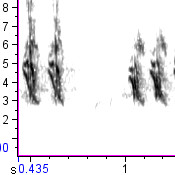 |
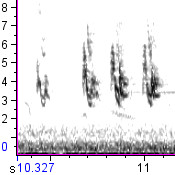 |
| Hoary Redpoll, Safety Sound, near Nome, Alaska, 5/14/2013. Click to listen | Hoary Redpoll, Kougarok Road, near Nome, Alaska, 6/4/2013. Click to listen | Hoary Redpoll, Dalton Highway, Alaska, 6/10/2006. Click to listen |
Within flocks, redpolls tend to sound the same. Between flocks, they tend to sound different. These differences can be pretty large in geographic scope: I got recordings of three different redpoll flocks last winter from three different Colorado counties, and they are all pretty similar to one another. But they are quite different from the redpolls in Washington and Alberta.
This is the pattern we would expect to see if flockmates match one another’s calls. We would expect birds in one flock to converge on a common pattern, while birds in another flock converge on a different common pattern. If redpolls respond preferentially to birds of a similar call type (like crossbills, their closest relatives within the Carduelinae), that would explain why Herremans’ captive Hoary Redpolls showed little response to the calls of wild Commons flying by. Maybe it was because they weren’t conspecifics — but maybe it was just because they weren’t flockmates.
So…
There may be consistent differences between the vocalizations of the redpoll species. Perhaps they use vocal differences to reject mates of the wrong species. Perhaps we can use differences to tell the species apart. But we can’t do that on current knowledge. There simply aren’t enough available recordings to document the limits of variation within species, in order to hash out the differences between species, if they exist.
There’s also the question of whether Hoaries and Commons in the same winter flocks may match each other’s calls. We don’t know whether they do, but given the willingness of these species to match calls of even Pine and Eurasian Siskins in captivity, it’s at least possible.
So it’s premature, I think, to try identifying redpolls by voice. But that’s no excuse to ignore it. We need to learn more about the calls of these birds, and for that we need more recordings. The next time the redpolls come south, I hope they meet a barrage of microphones.

